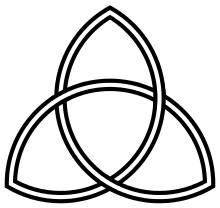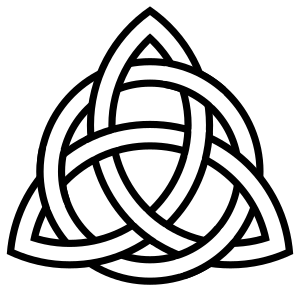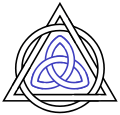Triquetra

Triquetra (/traɪˈkwɛtrə/; Latin tri- "three" and quetrus "cornered") originally meant "triangle" and was used to refer to various three-cornered shapes. It has come to refer exclusively to a particular more complicated shape formed of three vesicae piscis (the leaf-like shape in between two equal diameter circles when both centers are on the circumference of the other circle), sometimes with an added circle in or around the three lobes. Also known as a "trinity knot" when parallel doubled-lines are in the graph, the design is used as a religious symbol adapted from ancient Celtic images by Christianity. It is similar to Odin's symbol, the valknut.
Ancient usage
Germanic paganism
The triquetra has been found on runestones in Northern Europe and on early Germanic coins. It presumably had pagan religious meaning and it bears a resemblance to the valknut, a symbol associated with Odin.
Celtic art
The triquetra is often found in insular art, most notably metal work and in illuminated manuscripts like the Book of Kells. It is also found in similar artwork on Celtic crosses and slabs from the early Christian period. The fact that the triquetra rarely stood alone in medieval Celtic art has cast reasonable doubt on its use as a primary symbol of belief. In manuscripts it is used primarily as a space filler or ornament in much more complex compositions, and in knotwork panels it is a design motif integrated with other design elements. This widely recognised knot has been used as a singular symbol for the past two centuries by Celtic Christians, pagans and agnostics as a sign of special things and people that are threefold.[1]
Christian use
The symbol has been used by Christians as a sign of the Trinity (Father, Son and Holy Spirit), especially since the Celtic revival of the 19th century. When modern designers began to display the triquetra as a stand-alone design, it recalled the three-leafed shamrock which was similarly offered as a Trinity symbol by Saint Patrick. have also suggested that the triquetra has a similarity to the Christian Ιχθυς symbol. The triquetra has been used extensively on Christian sculpture, vestments, book arts and stained glass. It has been used on the title page and binding of some editions of the New King James Version.
A very common representation of the symbol is with a circle that goes through the three interconnected loops of the triquetra. The circle emphasises the unity of the whole combination of three forces. It is also said to symbolise God's love around the Holy Trinity.
Japanese use
The triquetra has been a known symbol in Japan called Musubi Mitsugashiwa.
Modern use
In contemporary Ireland, it is traditional for lovers to exchange jewelry such as a necklace or rings signifying their affection. The triquetra, also known as a "trinity knot", is often found as a design element is popular Irish jewelry such as claddaghs and other wedding or engagement rings.[2]
Neopaganism
It is difficult to date the exact origin of the Irish triquetra, and whether it was first used in a Christian or pagan context; the distinctive interlace/knotwork artistic style did not fully develop until ca. the 7th century AD, but the triquetra is the simplest possible knot. Celtic pagans, or even neopagans who are not of a Celtic cultural orientation, may use the triquetra to symbolise a variety of concepts and mythological figures.
Due to its presence in insular Celtic art, Celtic Reconstructionists use the triquetra either to represent one of the various triplicities in their cosmology and theology (such as the tripartite division of the world into the realms of Land, Sea and Sky),[3] or as a symbol of one of the specific Celtic triple goddesses, for example the battle goddess, The Morrígan.
Germanic neopagan groups who use the triquetra to symbolise their faith generally believe it is originally of Norse and Germanic origins.
The symbol is also sometimes used by wiccans and some new agers to symbolise the Triple Goddess, or as a protective symbol.[4]
Popular culture

In art
- The triquetra is often used artistically as a design element when Celtic knotwork is used. Many who identify as modern Celts may use the symbol to display an identification with Celtic culture, whether they live in the Celtic Nations or the diaspora.
In brands and logos
- The South American Holding GSA UNASUR use the triquetra as their main symbol
- The TNA clothing brand, exclusive to Aritzia, has a logo composed of three triquetras
- Game developers Treyarch use the triquetra as their company logo
- The flag of the Scottish Republican Socialist Movement
- Jersey logo for the KHL hockey team Neftekhimik
- Suarez International, a tactical arms company, uses a stylised triquetra as their logo
- S.C.ooT.'s Never Alone Resource Center's Logo
- The ThyssenKrupp AG and Krupp logos indirectly evoke the theme
In film
- A necklace with a triquetra (trinity knot) pendant is used in the film Constantine to give its bearer a spiritual "bulletproof vest".
- In the motion picture Thor a triquetra symbol is displayed on Thor's hammer Mjollnir in response to incantations and other magical stimuli.
- In the 2013 film Safe Haven, a necklace with a trinity symbol was given to Katie by her husband.
- In the 2004 film National Treasure, Nicolas Cage locates Trinity Church as the place where the treasure could be buried because of the symbol displayed in a flag.
In games
- The symbol appears as three different items in The Binding of Isaac: Rebirth called the Body, the Mind, and the Soul.
- A triquetra is seen on the floor of the laboratory, among other symbols, at the end of the video game Assassin's Creed.
- The triquetra is often compared to the "triforce" in the Legend of Zelda video game series.
- The triquetra appears as a sticker in LittleBigPlanet.
- The triquetra is a shotgun found in Borderlands 2 that, when fired, forms a triquetra spread.
- The triquetra is found in the laboratory on Outlast.
- The triquetra is found inscribed on the Huntsman's axe in The Wolf Among Us.
- The triquetra is found inscribed on the hilt of the steel shortsword in The Elder Scrolls IV: Oblivion. It is also found on Breton items in The Elder Scrolls Online.
- The triquetra is used as the general symbol for the pagan religions in Crusader Kings II.
- The triquetra can be selected as a tattoo on the lower right side of the back in Grand Theft Auto V (when playing as Michael).
- The triquetra is found stitched to Junpei's hat in Persona Q: Shadow of the Labyrinth
- The triquetra is the symbol for alliances in Dofus
- The triquetra is featured on the chest plates of the Sigrún and Valkyrie skins for Mercy in Overwatch
In literature and publications
- The double triquetra is used to represent the Holy Trinity on the New King James Version Bibles, published by Thomas Nelson, Inc.
In music
- A triquetra is one of the four symbols on the cover of Led Zeppelin's fourth album, where it used as the personal symbol of bassist John Paul Jones.
- The band Payable on Death (P.O.D.) uses this symbol on most of their CD covers.
- The triquetra is part of The Script's symbol of "Science and Faith".
- ApologetiX uses a triquetra as a logo
In television
- Michonne's katana in the TV series The Walking Dead features a triquetra on the inner crossguard. Custom-designed for the character, propmaster John Sanders intentionally chose the triquetra for its meaning as a triple goddess symbol.[5][6]
- The triquetra in a circle became well-known as the cover motif on the Book of Shadows in the American TV show Charmed. It represents the three sister witches' working together as one, and the sisters' "power of three" when united.
- The triquetra symbol was featured in the Ghost Whisperer season five episode "Lethal Combination".
- The Vampire Diaries season 5.07 – Death and the Maiden used the triquetra when Tessa had all three doppelgängers together and was trying to change the Anchor from Amara to Bonnie.
- The triquetra is used in the fourth season of the TV series Falling Skies, where it is worn on a necklace by the residents of Chinatown. A much larger triquetra decorates the wall of a shrine in Chinatown. It is explained that the symbol represents unity, a core value among the members of the community, who wilfully decide not to fight the Espheni.
Geometry
Topologically, the interlaced form of the plain triquetra is a trefoil knot.
Gallery of variant forms
-

Triquetra composed exactly of three overlapping Vesica piscis symbols.
-

An interlaced double Triquetra.
-

Tightly-knotted form of triquetra.
-

Triquetra interlaced with circle as Christian Trinitarian symbol (a "Trinity knot").
-

Triquetra in blue as part of an interlaced Christian Trinitarian decorative symbol.
-

The cross of triquetras, or "Carolingian cross".
-
Triquetra on one of the Funbo Runestones, located in the park of Uppsala University.
-
Close-up of a triquetra on one of the Funbo Runestones.
-
Four triquetras forming a Celtic cross in the church of Santa Susanna in Galicia.
Literature
- Hallvard Trætteberg: "Triquetra", article in the Scandinavian encyclopaedia Kulturhistorisk leksikon for nordisk middelalder, vol. 18, p. 634–635
- Martin Blindheim: Graffiti in Norwegian stave churches c. 1150 – c. 1350, Oslo 1985, i.a. p. 44–45
See also
References
- ↑ In Search of Meaning, Dalriada Magazine 2001
- ↑ McMahon, S. (1999). Story of the Claddagh Ring, Mercier Press
- ↑ Mac Mathúna, Liam (1999) "Irish Perceptions of the Cosmos" Celtica vol. 23 (1999), pp.174–187
- ↑ Cunningham, Scott (2004) [1988], "Rune Magic", Wicca: A Guide to the Solitary Practitioner, Woodbury, MN, U.S.A.: Llewellyn, p. 191, ISBN 978-0-87542-118-6
- ↑ Ross, Dalton; Snetiker, Marc (17 November 2013). "Michonne's Katana". Entertainment Weekly. Retrieved 30 October 2016.
- ↑ Keveney, Bill (12 October 2014). "'The Walking Dead,' up close and personal". USA Today. Retrieved 30 October 2016.